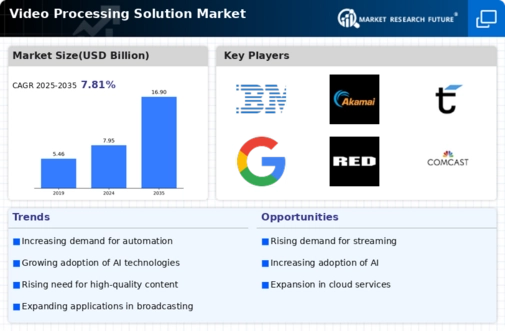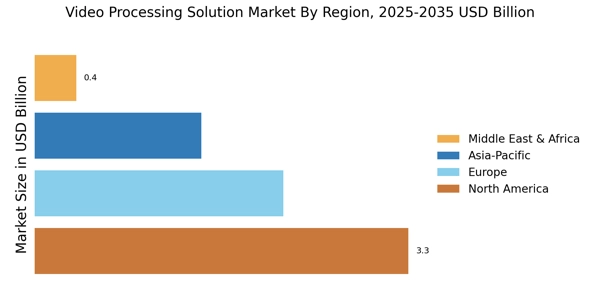The Video Processing Solution Market is currently characterized by a dynamic competitive landscape, driven by rapid technological advancements and increasing demand for high-quality video content across various sectors. Key players such as Adobe (US), NVIDIA (US), and Intel (US) are at the forefront, each adopting distinct strategies to enhance their market positioning. Adobe (US) focuses on innovation through its Creative Cloud suite, continually integrating AI capabilities to streamline video editing processes. NVIDIA (US), renowned for its graphics processing units, emphasizes partnerships with content creators and gaming companies to leverage its hardware for superior video processing. Meanwhile, Intel (US) is investing heavily in research and development to enhance its hardware capabilities, particularly in real-time video processing, which is crucial for applications in broadcasting and streaming. Collectively, these strategies contribute to a competitive environment that is increasingly centered around technological innovation and user-centric solutions.
In terms of business tactics, companies are localizing manufacturing and optimizing supply chains to enhance efficiency and reduce costs. The market appears moderately fragmented, with a mix of established players and emerging startups vying for market share. This fragmentation allows for diverse offerings, yet the influence of key players remains substantial, as they set industry standards and drive technological advancements that smaller companies often follow.
In September 2025, Adobe (US) announced the launch of a new AI-driven feature within its Premiere Pro software, aimed at automating video editing tasks. This strategic move is likely to enhance user experience by significantly reducing editing time, thereby attracting a broader user base, including amateur creators and professionals alike. The integration of AI not only positions Adobe as a leader in innovation but also reflects a growing trend towards automation in video processing solutions.
In August 2025, NVIDIA (US) unveiled its latest graphics card, designed specifically for video processing applications, which promises to deliver unprecedented rendering speeds. This development is strategically important as it reinforces NVIDIA's commitment to providing cutting-edge technology that meets the evolving demands of content creators. By focusing on performance enhancements, NVIDIA is likely to strengthen its competitive edge in the market, appealing to high-end users who require superior processing capabilities.
In July 2025, Intel (US) entered into a partnership with a leading streaming service to develop optimized hardware solutions for live broadcasting. This collaboration is indicative of Intel's strategy to penetrate the growing live-streaming market, which has seen a surge in demand. By aligning with a prominent player in the streaming industry, Intel not only enhances its product offerings but also positions itself as a key enabler of next-generation video processing technologies.
As of October 2025, the Video Processing Solution Market is witnessing trends that emphasize digitalization, sustainability, and the integration of artificial intelligence. Strategic alliances among key players are shaping the competitive landscape, fostering innovation and collaboration. Moving forward, it is anticipated that competitive differentiation will increasingly hinge on technological advancements rather than price, with a focus on reliability in supply chains and the ability to deliver innovative solutions that meet the diverse needs of consumers.


















Leave a Comment